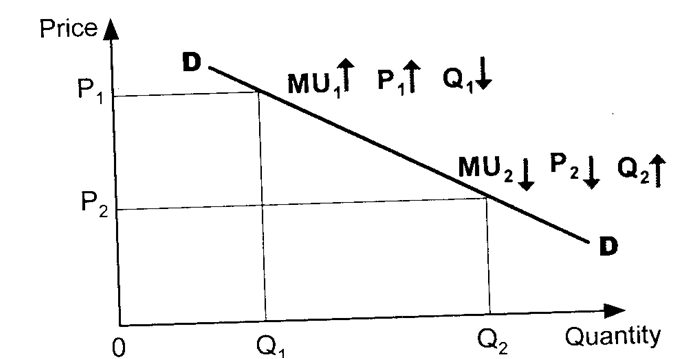The law of diminishing marginal utility
which states that, as more of the commodity is consumed, marginal
utility (MU) declines. As marginal utility declines, the consumer is willing to pay less for the commodity.

The total utility from consuming a commodity say commodity X
depends on the quantity of commodity X consumed. The first unit of
commodity X is the best out of the lot available to the consumer and
gives the consumer the highest satisfaction. The consumer is prepared to pay the highest price for the first unit. The second unit of X gives the consumer less satisfaction and is prepared to pay a lower price than the first one. Subsequent units give lesser satisfaction. This is because the need that commodity X covers is gradually satisfied. Total utility is the sum of marginal utilities obtained by the consumer from different units of a commodity.
For instance, TU4 - MU-, + MU2 + MU3 + MU4.
-Suppose MU! = 27,MU2 = 23,.MU3 = 15, and MU4 = 11, thenTU4 = 76.
Consumer's utility schedule for commodity X
Units of a Commodity 1 2 3 4 5 6 7 8 9
Total utility 27 50 65 76 84 92 93 93 92
Marginal utility 27 23 15 11 8 6 1 0 -1

Substitution effect
When the price of the commodity falls, price of other substitutes
remaining constant, the consumer will buy more of this commodity
other than substitutes. This commodity will receive new consumers.
Quantity demanded increases at a lower price. However, if the price of the commodity increases, other things remaining constant, less of this commodity will be demanded. The consumer will look for cheaper substitutes. The substitution effect is the rate at which one commodity is substituted for the other, other things remaining constant.
Real income effect
Real income is money income over price. It is the actual quantity of
goods obtained from the money income. When the price decreases, the real income of the consumer increases. The consumer now spends less on the same amount of the commodity.
He is capable of buying more with the same amount of money. If the price increases, the real income of the consumer falls and has to spend more on the same amount of the commodity. Less is being bought with the same amount of money.